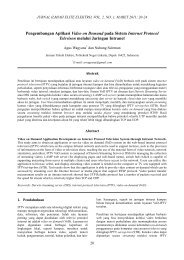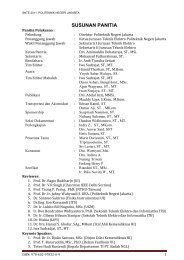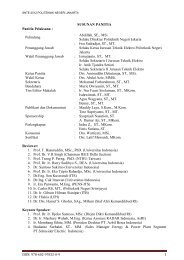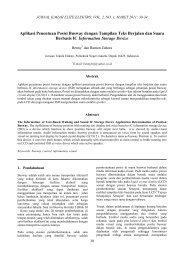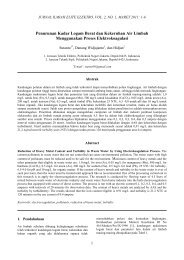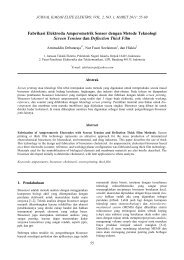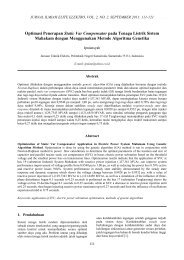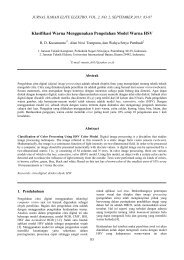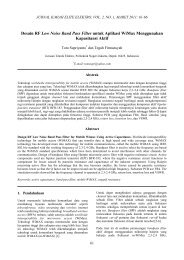Buku Prosiding Seminar Nasional Tahun 2012 - ELEKTRO ...
Buku Prosiding Seminar Nasional Tahun 2012 - ELEKTRO ...
Buku Prosiding Seminar Nasional Tahun 2012 - ELEKTRO ...
- No tags were found...
You also want an ePaper? Increase the reach of your titles
YUMPU automatically turns print PDFs into web optimized ePapers that Google loves.
TL | 34SS( p)( 1−p)2Z= (1)2cwhere Z is Z value (e.g. 1.96 for 95% confidence level);p is percentage picking a choice, expressed as decimal(0.5 used for sample size needed); and c is confidenceinterval, expressed as decimal. For finite population,providing the predetermined population size (pop),corrected SS can be determined as:SScorrected SS = SS −1(2)1+popAnother quick way to determine the required samplesize is by using the sample size table, which is availableonline as shown in [2]. In this study, three types oflamps, i.e. Incandescent Lamp (IL), Fuorescent Lamp orTubular Lamp (TL), and Compact Fluorescent Lamp(CFL) are considered to be asked regarding to theirutilization in the questionnaire. As shown in Figure 1below, the questionnaire template is adopted from [3].which is obtained form the survey and number of surveyparticipants or here is sample size (SS), as:SLTALH = (3)SSTotal number of lamps in all households is thenestimated based on the number of specific lamp type(SLT), sample size (SS), and number of electrifiedhouseholds or here is considered as population size(pop) as:ETLH = SLTSS(4)( pop)Average daily operating hours (ADH) is determinedbased on total number of operating hour of the lamptype in the surveyed households (TNHL), and totalnumber of lamp type in the surveyed households (TNL)as [4]:TNHLADH = (5)TNL3. Results and DiscussionFigure 1.Questionnaire template to obtain daily lamputilization in the residential sector.The BEU for household’s lamp utilization can then beobtained by conducting four essential assessment afterthe lamp utilization data have been gathered. Thefollowing baseline, such as the number of lamps of eachlamp type in the surveyed households, average numberof lamps per household, estimation of total number oflamps in all households, and average daily operatinghour of each lamp, will then be revealed according tothe followings [3]. Number of lamps of each lamp typeare obtained by conducting survey. The surveyparticipants are asked to fill up the questionnaire asshown in Fig. 1. The variety of IL, TL , and CFL areobtained from this stage. Furthermore, the result of thisinitial assessment will be used to determine other dataof the following three assessment and other usefulcharacteristic of lighting utilization, such as diversityfactor (DF) and coincidence factor (CF).Average number of lamps per household (ALH) iscalculated based on the ratio between number ofspecific lamp type (SLT) having certain rated wattAs described in earlier section, number of household tobe surveyed is determined based on Equation (1) and (2).Therefore, a total number of required sample is 384respondents which is equivalent to the same number ofhousehold, considering 762,248 households in Surabaya.The questionnaire is then distibuted randomly to allSurabaya areas, consisting of West, East, South, North,and Central. Composition of questionnaire distributionfor lamp utilization survey in Surabaya is presented inthe following figure.East;110; 28%Figure 2.North;39; 10%West; 64;17%Center;34; 9%South;137; 36%Questionnaire distribution for lamp utilizationsurvey in SurabayaForm Fig. 2, we can see that the South Surabaya areahas the largest respondents with 137 householdsSNTE-<strong>2012</strong> ISBN: 978-602-97832-0-9




